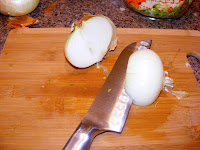 |
| On the vine in my kitchen garden. |
It may be Labor Day, but my tomato plants are still in heavy production mode, and probably will be for some time. And when I look around my dinner table of an evening, I see seven happy, hungry faces looking back at me.
So I make a lot of tomato sauce.
A. Lot.
 |
| Today's harvest |
It's not that smooth ultra-processed stuff from a can, but a rustic sauce full of yummy goodness that freezes beautiful and is the easiest way I know to get maximum flavor out of summer tomato bounty.
Here's what you need for 2 quarts:
5.25 lbs ripe tomatoes (I use a combination of mostly Roma with a few dark heirlooms thrown in to enrich flavor profile)
1 large sweet onion, peeled and roughly chopped (about 3/4 lb)
1 bulb garlic (you can use less, but I like a garlicky sauce and garlic has good antioxidants)
Italian seasoning
brown sugar
salt & pepper
 |
| Here's 5.25 pounds of tomatoes. The heirlooms are a darker color, funky shaped. The Romas are, well, Romas, those brighter colored oval shaped tomatoes. |
 |
| Trimmed Romas. |
Trim your tomatoes & rough chop. That means cut each one in half, and trim out the white part nearest to the stem, any green non-ripe bits, cracks near the stem or dark spots on the skin. Give each half a squeeze over the sink to dump out the seedy pulpy part.
Make a quick slice in each half to quarter them.
 |
| Rough chopped heirloom. These have more juice and seeds than Romas. |
Throw them all in a big bowl. Once trimmed and squeezed I have about 5 lbs of rough chopped tomatoes.
 |
| Rough chopped onions. |
Peel and rough chop onions. Today I scored some wonderful red torpedo and candy onions from my CSA, so I'm using a combo of about 3/4 lb all together. Often I just use a nice big Vidalia.
 |
| Fancy flavored olive oils. |
So you know that bottle of fancy olive oil you bought that time for one recipe and now you don't know what to do with the rest of it? Well now you do.
Drizzle everything in the bowl with olive oil. Really, any kind will do, but today I used some Balsamic-garlic oil. Use whatever you have. It will be fine.
 |
| Smashed peeled garlic. |
 |
| Garlic in its little foil package. |
Now to the garlic.
Garlic is wonderful good-for-you stuff and I use a lot of it. But I hate the lingering smell of raw garlic on my hands. So I indulge in the pre-peeled kind. Melissa's makes my favorite brand. It's a pouch with a lot of little pouches that each contain a whole bulb of garlic, already magically peeled. Take your bulb of peeled garlic and put it into a little "bowl" you make out of a small piece of foil. Drizzle olive oil over it, seal it up.
 |
| Double-lined baking sheet. Much easier cleanup. |
Why are we doing this, you ask? Well, we're roasting our ingredients and this is the best way to roast garlic. Leave these small bits exposed and they tend to burn. And roasting garlic enhances its flavor and brings out natural sweetness.
Line a large rimmed baking sheet with foil. Double-line: two sheets regular foil across, and one sheet nonstick lengthwise. You'll be glad you did.
 |
| Ready to go in the oven. |
 |
| Out of the oven. |
Let everything cool for 30 minutes. Gather the corners of your foil lining to lift contents out of the pan and carefully transfer to your food processor. There will be a good amount of hot liquid in there, so be careful.
Empty your lovely little packet of fragrant roasted garlic in there as well.
 |
| Finished sauce. |
And if you are me and you have more fresh basil in your garden than you know what to do with, you throw in a good handful of that as well.
Process your sauce to the texture of your liking, as chunky or as smooth as you like. Here's mine.
Mmmmmmnnnnn! Yummy!
Made two quarts. Leave headroom if you intend to freeze. I've over-filled and had a 'splosion in the freezer. Not pretty.
















